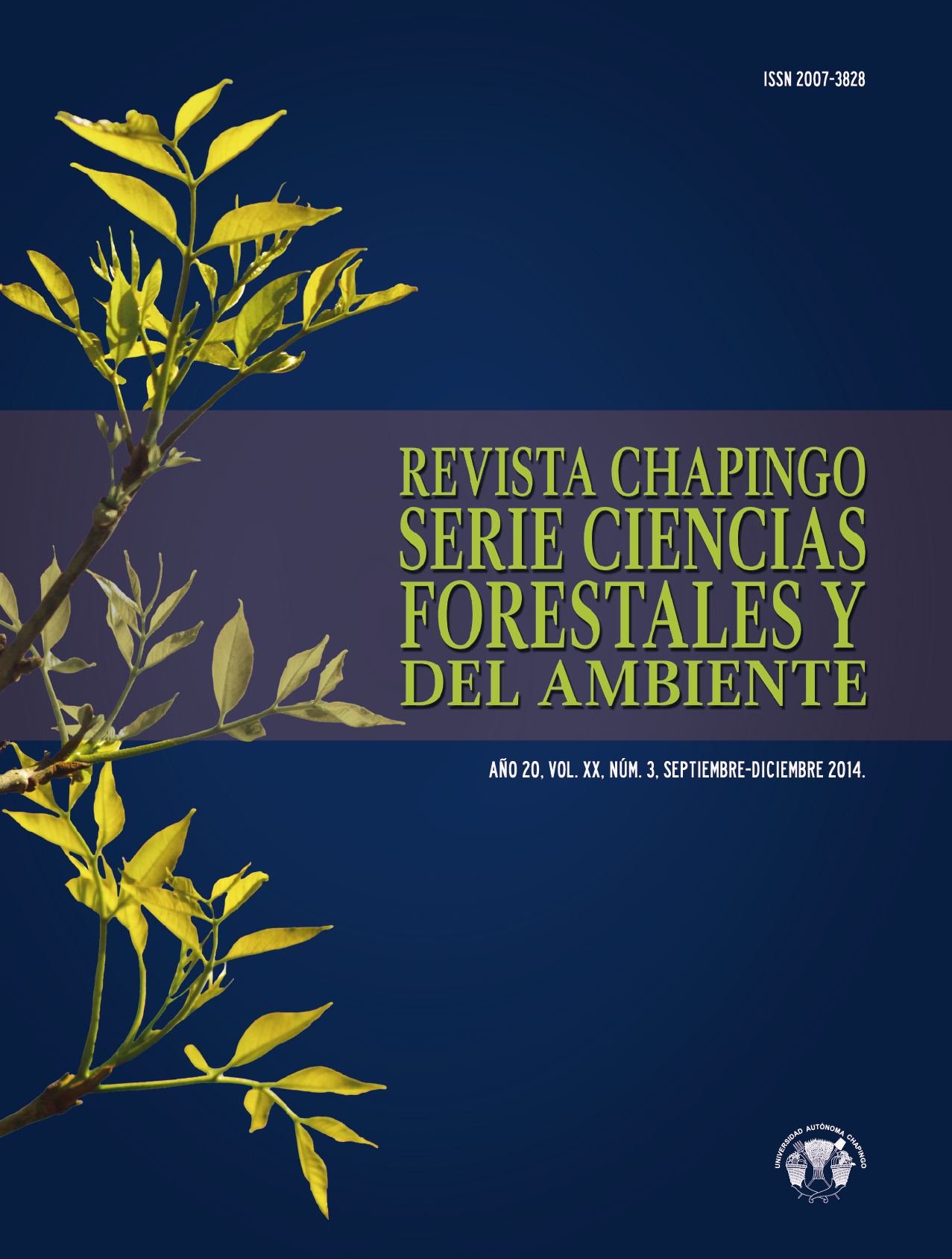Abstract
Three irrigation periods (every 48, 96 and 192 hours) were evaluated with the purpose of improving the preconditioning Pinus engelmannii Carr. seedlings in nursery. Eight months old seedlings were evaluated for 40 days. The study was conducted under greenhouse conditions at the nursery of the Experimental Station Valle del Guadiana of INIFAP. The data were analyzed with a permutations test. The results show that irrigation every 48 h caused the best effects in height (7.70 cm), diameter (4.38 mm), total biomass (6.59 g) and Dickson’s quality index (0.55). In contrast, water stress caused by treatment with irrigation every 192 h (-1.22 MPa) limited the growth of seedlings; however, the lignification index (26.63) was significantly better (P = 0.0001) with this frequency of irrigation. Despite having significant differences (P = 0.0001) in the hydric potential and morphological variables, there was not sufficient evidence to define an absolutely superior treatment to improve the preconditioning of seedlings in the nursery. Therefore, it is advisable to evaluate these treatments for a longer time; moreover, it is suggested to evaluate the same treatments in the plantation field
References
Candel, P. D., Lucas, B. M., & Linares, J. C. (2012). Predicciones del crecimiento en poblaciones de pino laricio (Pinus nigra Arn. ssp. salzmannii) bajo diferentes escenarios futuros de cambio climático. Revista Ecosistemas, 21(3), 41–49. doi: https://doi.org/10.7818/ECOS.2012.21-3.06
Cleary, B., Zaerr, J., & Hamel, J. (1998). Guidelines for measuring plant moisture stress with a pressure chamber. Oregon, USA: SPM Instrument Company.
Cochard, H., Hölttä, T., Herbette, S., Delzon, S., & Mencuccini, M. (2009). New insights into the mechanisms of water-stressinduced cavitation in conifers. Plant Physiology, 151(2), 949–954. doi: https://doi.org/10.1104/pp.109.138305
Comisión Nacional Forestal (CONAFOR). (2011). Informe anual de reforestación. http://www.conafor.gob.mx/portal/
Davis, A. S., & Jacobs, D. F. (2005). Quantifying root system quality of nursery seedlings and relationship to outplanting performance. New Forests, 30(2- 3), 295–311. doi: https://doi.org/10.1007/s11056-005-7480-y
Dickson, A., Leaf, A. L., & Hosner, J. F. (1960). Quality appraisal of white spruce and white pine seedling stock in nurseries. The Forestry Chronicle, 36(1), 10–13. doi: https://doi.org/10.5558/tfc36010-1
Hölttä, T., Juurola, E., Lindfors, L., & Porcar-Castell, A. (2012). Cavitation induced by a surfactant leads to a transient release of water stress and subsequent run away embolism in Scots pine (Pinus sylvestris) seedlings. Journal of Experimental Botany, 63(2), 1057–1067. doi: https://doi.org/10.1093/jxb/err349
Landis, T. D., Tinus, R. W., McDonald, S. E., & Barnett, J. P. (1989). Seedling nutrition and irrigation. Washington, DC, USA: Department of Agriculture-USDA Forest Service.
Lopushinsky, W., & Max, T. A. (1990). Effect of soil temperature on root and shoot growth and on budburst timing in conifer seedling transplants. New Forest, 4(2), 107–124. doi: https://doi.org/10.1007/BF00119004
Manly, B. F. J. (2007). Randomization, bootstrap and Monte Carlo methods in biology (3rded.). Boca Raton, FL, USA: Chapman & Hall-CRC Press.
Martiñón-Martínez, R. J., Vargas-Hernández, J., López-Upton, J., Gómez- Guerrero, A., & Vaquera-Huerta, H. (2010). Respuesta de Pinus pinceana Gordon a estrés por sequía y altas temperaturas. Revista Fitotecnia Mexicana, 33(3), 239-–248. http://www.redalyc.org/articulo.oa?id=61014249007
Moreno, L. P. (2009). Respuesta de las plantas al estrés por déficit hídrico: Una revisión. Agronomía Colombiana, 27(2), 179–191. http://www.revistas.unal.edu.co/index.php/agrocol/article/view/11131/11799
Prieto, R., J. A. (2005). Características de la planta y recomendaciones para su transporte al sitio de plantación. Durango, México: CEVAG-CIRNOC-INIFAP
Prieto, R. J., Cornejo, O. E., Calleros, D. P., Návar, C. J., Marmolejo, M. J., & Jiménez, P. J. (2004). Estrés hídrico en Pinus engelmannii Carr., producido en vivero. Forest Systems, 13(3), 443–451. http://www.inia.es/gcontrec/pub/443-451-%286704%29- Estres_1161947232765.pdf
Prieto-Ruiz J., Almaraz, R. R., Corral, R. J., & Díaz-Vázquez. A. (2012). Efecto del estrés hídrico en Pinus cooperi Blanco durante su preacondicionamiento en vivero. Revista Mexicana de Ciencias Forestales, 3(12), 19–28. http://revistas.inifap.gob.mx/index.php/Forestales/article/view/1845/1837#
Ritchie, G. A., & Landis, T. D. (2010). Assessing plant quality. Seedling processing, storage and outplanting. Washington, DC, USA: US Department of Agriculture Forest Service,
Salle, A., Ye, H., Yart, A., & Lieutier, F. (2008). Seasonal water stress and the resistance of Pinus yunnanensis to a barkbeetle- associated fungus. Tree physiology, 28(5), 679-–687. doi: https://doi.org/10.1093/treephys/28.5.679.
Sánchez, S. R., Navarro, C. R., Camarero, J. J., Fernández, C. A., Swetnam, T. W., & Zavala, M. A. (2012). Vulnerabilidad frente a la sequía de repoblaciones de dos especies de pinos en su límite meridional en Europa. Revista Ecosistemas, 21(3), 31–40. doi: https://doi.org/10.7818/ECOS.2012.21-3.05
Thompson, B. E. (1985). Seedling morphological evaluation. Seedling morphology. In Duryea M. L. (Ed.), Evaluating seedling quality: Principles, procedures and predictive abilities of major tests (pp. 59–71). Corvallis, OR, USA: Forest Research Laboratory, Oregon State University.

This work is licensed under a Creative Commons Attribution-NonCommercial 4.0 International License.
Copyright (c) 2014 Revista Chapingo Serie Ciencias Forestales y del Ambiente



